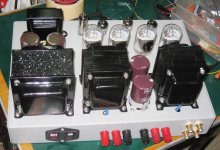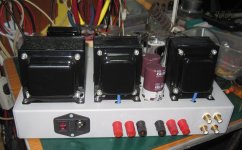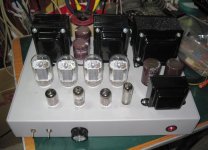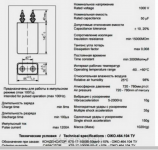My working monoblock tube amps for the last 10 years have a 500V 3000mF power supply. No RC filter in the supply. LM317 voltage regulated driver stage and screens on the 4 output tubes/channel. The voltage and PS ripple is well within the specs of the filter caps, yet I am concerned about failure with 375 joules. Should I be? Any experience?
Last edited:
Check the capacitor's ripple voltage periodically.
Excellent advice.
And… be very very very careful when checking the ripple. Shorting the 3000 µF at 450-to–500 volts delivers
Blew apart the tip of a multimeter tester. I wasn't even using 450 to 500 volts. Only about 170 V on a 2,200 µF big tin can capacitor. I “slipped”, shorting the contacts. Entirely vaporized the errant meter probe. Nothing left. Same for most of the screw-terminal. Poor capacitor. Couldn't hear a thing for at least a minute.
The one 'nice' thing about the higher-voltage electrolytic capacitors is that during their useful life, before they start drying out, the dielectric actually becomes 'stronger'. The high voltage induces further electrolytic deposition of oxide goodness at a very slow rate. Once they dry out though… just the opposite. The film goes to pôop, fast.
Just saying,
GoatGuy ✓
E = ½CV²
E = 0.5 × 3000×10⁻⁶ F • (450 to 500)²
E = 300 to 375 J
That'll definitely wake you up and make you go crazy. Instantly. I know, I've accidentally done it. E = 0.5 × 3000×10⁻⁶ F • (450 to 500)²
E = 300 to 375 J
Blew apart the tip of a multimeter tester. I wasn't even using 450 to 500 volts. Only about 170 V on a 2,200 µF big tin can capacitor. I “slipped”, shorting the contacts. Entirely vaporized the errant meter probe. Nothing left. Same for most of the screw-terminal. Poor capacitor. Couldn't hear a thing for at least a minute.
The one 'nice' thing about the higher-voltage electrolytic capacitors is that during their useful life, before they start drying out, the dielectric actually becomes 'stronger'. The high voltage induces further electrolytic deposition of oxide goodness at a very slow rate. Once they dry out though… just the opposite. The film goes to pôop, fast.
Just saying,
GoatGuy ✓
1. Safety First!
Do calculate and wire in a proper Bleeder Resistor(s).
Be sure to calculate how many minutes it takes to discharge to a safe voltage.
Suppose the filaments or filament supply dies at turn on. But the B+ is alive.
When you turn the amp off, there is nothing other than [You] to discharge all those Joules.
Most of us on this forum know all this. I am only preaching to those who are not using a Bleeder, or do not know to use a Bleeder.
2. Just to bring us all up-to-speed, the commonly used terms for capacitance changed decades ago.
I think you meant 3000uF.
3000mF is sometimes interpreted as 3000 milli Farad. That would be 3 Farad.
3 Farad is getting to within a few decades of a linear accelerator's supply.
Do calculate and wire in a proper Bleeder Resistor(s).
Be sure to calculate how many minutes it takes to discharge to a safe voltage.
Suppose the filaments or filament supply dies at turn on. But the B+ is alive.
When you turn the amp off, there is nothing other than [You] to discharge all those Joules.
Most of us on this forum know all this. I am only preaching to those who are not using a Bleeder, or do not know to use a Bleeder.
2. Just to bring us all up-to-speed, the commonly used terms for capacitance changed decades ago.
I think you meant 3000uF.
3000mF is sometimes interpreted as 3000 milli Farad. That would be 3 Farad.
3 Farad is getting to within a few decades of a linear accelerator's supply.
Last edited:
I have an old HP6448B power supply. It is an old style 60 Hz switcher that has 4 X 1000 uF 450 volt capacitors in series parallel to create a 1000uF 900 volt cap. It is wired directly across the output. I turned up the internal pots so that I can get 650 volts at 1.7 amps continuous from it until the mains breaker trips, while still maintaining regulation.
1000uF charged to 650 volts works out to 211 Joules. There have been a few spectacular mishaps fueled by this supply. A couple just made components vanish without a trace leaving only a black stain on the PC board. In other cases, stuff exploded.
One was a 22uF 450 volt cap fed by a 10 K 1 watt resistor. I was turning up the power supply and the audio generator at the same time while watching the audio power meter climb, not paying attention to how high the B+ was. Somewhere around 600 volts that 450 volt electrolytic shorted, then exploded with a report like a 12 gauge shotgun. It and the 10K resistor were never found, not even when I moved house and cleaned up the entire room.
More recently a dumb mistake at arithmetic had me feed about 400 watts of power while aiming for 40, to a 24 watt TV sweep tube only to have it violently EXPLODE. Not recognizing my mistake, I did it again. The second tube did not explode, but the glass was broken. Autopsy revealed a tube arc had struck and all that supply's energy went into the tube. The wire connecting up the cathode in the tube had vaporized, as did the cathode pin running through the glass, which caused breakage.
More recently I was squeezing about 160 watts out of a pair of TV sweep tubes when a resistor connected to the plate of one tube failed causing an arc from the plate side of the resistor to the ground plating on the PC board. This vaporized that end of the resistor and burned a hole through the PC board. This was not nearly as violent as the previous exploding parts, and I was about to find out why. With all the dead parts replaced the amp worked, but exhibited high distortion. I started swapping parts with the other channel without results until I came to the OPT. before I could swap it I found that it attracted my screwdriver....it had become a magnet! The DC resistance and inductance of the OPT had been the limiting factor in what would have been a bigger fireball.
I did successfully degauss the OPT, and the amp did recover. It's DCR still matches its brethren (I have several). It could have easily blown open circuit. I did manage to set one on fire maybe 15 years ago, but that's a different story.
Big energy storage has its advantages, and it's risks. Ordinary glass fuses EXPLODE violently on 500+ volts of DC since there is no zero crossing to quench the arc, and plenty of metal ions to make it grow. There are specialized fuses that can deal with this, but they are typically large and expensive. Fusing the cathode circuit of each output tube should help in the case of a runaway tube, which is a common failure, but will do nothing if an OPT or other component arcs.
1000uF charged to 650 volts works out to 211 Joules. There have been a few spectacular mishaps fueled by this supply. A couple just made components vanish without a trace leaving only a black stain on the PC board. In other cases, stuff exploded.
One was a 22uF 450 volt cap fed by a 10 K 1 watt resistor. I was turning up the power supply and the audio generator at the same time while watching the audio power meter climb, not paying attention to how high the B+ was. Somewhere around 600 volts that 450 volt electrolytic shorted, then exploded with a report like a 12 gauge shotgun. It and the 10K resistor were never found, not even when I moved house and cleaned up the entire room.
More recently a dumb mistake at arithmetic had me feed about 400 watts of power while aiming for 40, to a 24 watt TV sweep tube only to have it violently EXPLODE. Not recognizing my mistake, I did it again. The second tube did not explode, but the glass was broken. Autopsy revealed a tube arc had struck and all that supply's energy went into the tube. The wire connecting up the cathode in the tube had vaporized, as did the cathode pin running through the glass, which caused breakage.
More recently I was squeezing about 160 watts out of a pair of TV sweep tubes when a resistor connected to the plate of one tube failed causing an arc from the plate side of the resistor to the ground plating on the PC board. This vaporized that end of the resistor and burned a hole through the PC board. This was not nearly as violent as the previous exploding parts, and I was about to find out why. With all the dead parts replaced the amp worked, but exhibited high distortion. I started swapping parts with the other channel without results until I came to the OPT. before I could swap it I found that it attracted my screwdriver....it had become a magnet! The DC resistance and inductance of the OPT had been the limiting factor in what would have been a bigger fireball.
I did successfully degauss the OPT, and the amp did recover. It's DCR still matches its brethren (I have several). It could have easily blown open circuit. I did manage to set one on fire maybe 15 years ago, but that's a different story.
Big energy storage has its advantages, and it's risks. Ordinary glass fuses EXPLODE violently on 500+ volts of DC since there is no zero crossing to quench the arc, and plenty of metal ions to make it grow. There are specialized fuses that can deal with this, but they are typically large and expensive. Fusing the cathode circuit of each output tube should help in the case of a runaway tube, which is a common failure, but will do nothing if an OPT or other component arcs.
Last edited:
Thanks Tubelab. I can imagine a lot that could happen. The amps have been rock solid for over a decade. But given your experience, I will think about derating the power supply. "Misapplication hazardous" as it says right on the CD caps. Above a certain energy, it probably makes very little incremental benefit in the sound quality.
This starts to remind me of an 811 amplifier I used for a wile. It had lots of filter capacitance charged to about 900 volts. Fused with a 1A 250 volt glass fuse.
Plate voltage got shorted to ground and I could not find where the fuse went. It was not in the holder. I then noticed a powdery glass near where the fuse was and one end cap of the fuse.
Lesson here is that fuse could be a bit dangerous if the plate voltage shorts to ground and you are in some proximity to the fuse. I am sure there are better options for fusing than what I chose.
Plate voltage got shorted to ground and I could not find where the fuse went. It was not in the holder. I then noticed a powdery glass near where the fuse was and one end cap of the fuse.
Lesson here is that fuse could be a bit dangerous if the plate voltage shorts to ground and you are in some proximity to the fuse. I am sure there are better options for fusing than what I chose.
I am fearful enough when I use a 500uF cap.
More Joules ('power') to you both for your bravery (and careful actions).
i used two pcs, 1000ufd/450 vdc, on a 6LU8 pp amp i built...one each for each channel...
Attachments
The arc shown in that video was not pure DC, that is quite obvious from the loud 50 Hz buzz.
I have had some fun with arcs powered by both DC and AC. I have not experimented with the big HP due to it's large stored energy capability. I have experimented with some lower voltage supplies, and other sources with current limiting, or suitable ballasts like several large incandescent bulbs.
Years ago there was a popular carbon zinc battery called the #6 or later the EN6. We used them to start our model airplane engines in the early 60's, but their history goes back to the dawn of radio, powering DH triode filaments. Reproductions are still being made.
I discovered that the carbon rods used for the positive electrode in these things make for some neat arc lights, and can be used to cut or melt some metals when fed a suitable source of electricity. Most of my experiments with electricity as a kid were nowhere near safe, so won't be discussed here, but lets just say that his arc was a wimp compared to what you can do with a few car batteries, some jumper cables, and some carbon rods. Even more fun can be had with a real Craftsman arc welder.
Note...the carbon rods must be DRY. Several weeks in the Florida sun kind of dry, otherwise they explode.
I have had some fun with arcs powered by both DC and AC. I have not experimented with the big HP due to it's large stored energy capability. I have experimented with some lower voltage supplies, and other sources with current limiting, or suitable ballasts like several large incandescent bulbs.
Years ago there was a popular carbon zinc battery called the #6 or later the EN6. We used them to start our model airplane engines in the early 60's, but their history goes back to the dawn of radio, powering DH triode filaments. Reproductions are still being made.
I discovered that the carbon rods used for the positive electrode in these things make for some neat arc lights, and can be used to cut or melt some metals when fed a suitable source of electricity. Most of my experiments with electricity as a kid were nowhere near safe, so won't be discussed here, but lets just say that his arc was a wimp compared to what you can do with a few car batteries, some jumper cables, and some carbon rods. Even more fun can be had with a real Craftsman arc welder.
Note...the carbon rods must be DRY. Several weeks in the Florida sun kind of dry, otherwise they explode.
Hello,
Just my two cents as they say.
Isnt it always a good idea to use an RC network to het a bit of filtering and reduce noises coming from the rectifier?
I would always install a bleeder to be sure the caps are empty before you could open the chassis.
It is a lot of energy stored in the caps but would a cap designed to release its charge very quickly but having less charge be better?
I recently bought some Russian caps, still waiting for them to arrive.
greetings, Eduard
Just my two cents as they say.
Isnt it always a good idea to use an RC network to het a bit of filtering and reduce noises coming from the rectifier?
I would always install a bleeder to be sure the caps are empty before you could open the chassis.
It is a lot of energy stored in the caps but would a cap designed to release its charge very quickly but having less charge be better?
I recently bought some Russian caps, still waiting for them to arrive.
greetings, Eduard
Attachments
3000mF is sometimes interpreted as 3000 milli Farad.
Its _correctly_ interpreted as milli farad. The unit full names are not capitalized, the people they are named after are: Michael Faraday gets two units the farad (F) and the faraday.
SI multipliers and unit names are precisely defined and case sensitive and nearly every country in the world uses them. If your keyboard doesn't have a convenient 'µ' character available its an acceptable "cheat" to use 'u'.
One thing that always amazes me is how the many people who use pF and µF (but never nF or mF) are perfectly happy with ms, µs, ns and ps, and with mH, µH and nH. Capacitor land is a strange place it seems.
- Status
- This old topic is closed. If you want to reopen this topic, contact a moderator using the "Report Post" button.
- Home
- Amplifiers
- Tubes / Valves
- 375 Joules PS for my monoblock tube amps



